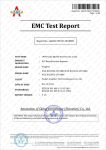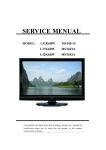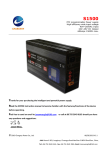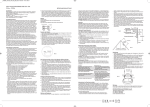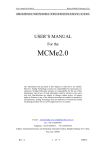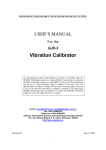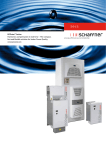Download FCC Test report for LED Panel Light Models ZY-P4
Transcript
4312774.50 FCC Test report for LED Panel Light Models ZY-P4-40W CDS series Guangzhou, date of issue: 2013-09-06 Author Ryan Liang By order of James Industry Group Co., Ltd at Hong Kong, China Author : Ryan Liang Pages : 19 pages Reviewed : Tim Yan Annex : NIL DEKRA Testing and Certification (Shanghai) Ltd. Guangzhou Branch Building A3, No.3 Qiyun Road, Science City, Guangzhou Hi-Tech Industrial Development Zone, Guangzhou, P.R. China Tel +86 20 6661 2000 Fax +86 20 6661 2001 www.dekra-certification.com Version: 3.0 - Page 2 of 19 - CONTENTS 4312774.50 page 1 Conclusion ............................................................................................................. 3 2 2.1 2.2 2.3 Summary ............................................................................................................... 4 Applied standards .................................................................................................. 4 Reference standards .............................................................................................. 4 Overview of results ................................................................................................ 4 3 Classification .......................................................................................................... 5 4 4.1 4.2 4.3 4.4 4.5 General Information ............................................................................................... 6 Model description ................................................................................................... 6 Product Information ................................................................................................ 8 Customer Information............................................................................................. 8 Product labeling ..................................................................................................... 9 User information..................................................................................................... 9 5 5.1 5.2 5.3 5.4 Test information ................................................................................................... 10 Test facility ........................................................................................................... 10 Measurement procedure ...................................................................................... 10 Test data .............................................................................................................. 10 Environmental conditions ..................................................................................... 10 6 6.1 6.2 6.3 Conducted emissions ........................................................................................... 11 Measurement procedure ...................................................................................... 11 Measurement equipment ..................................................................................... 11 Measurement data ............................................................................................... 12 7 7.1 7.2 7.3 Radiated emissions .............................................................................................. 15 Measurement procedure ...................................................................................... 15 Measurement equipment ..................................................................................... 15 Measurement data ............................................................................................... 16 8 Test setup and arrangement ................................................................................ 18 9 Product Internal Photo ......................................................................................... 19 Version: 3.0 - Page 3 of 19 - 1 4312774.50 CONCLUSION The device under test (DUT) as mentioned in this report complies with the stated requirements of the FCC Part 15, Class B. The tested system is classified as digital device Class B marked for use in a residential environment notwithstanding use in commercial, business and industrial environments. The conclusion and results stated in this test report are based on a non-recurrent examination of sample(s) provided by the applicant. The tests described in this report do not result in the right to use any approval mark as conferred by DEKRA Testing and Certification (Shanghai) Ltd. Guangzhou Branch As far as the tests were based on certain specifications; these are mentioned in the report. Version: 3.0 - Page 4 of 19 - 2 4312774.50 SUMMARY This chapter presents an overview of standards and results. Refer to the next chapters for details of measured test results and applied test levels. 2.1 Applied standards Standard Year Title FCC part 15 2013 Federal Communications Commission (FCC) – Radio Frequency Devices 2.2 Reference standards Standard ANSI C63.4 2.3 Year Title 2009 American National Standard for Methods of Measurement of Radio-Noise Emissions from Low-Voltage Electrical and Electronic Equipment in the Range of 9 kHz to 40 GHz Overview of results Emission tests Result Conducted emission PASS Radiated emission PASS Version: 3.0 - Page 5 of 19 - 3 4312774.50 CLASSIFICATION This chapter presents an overview of the applicable classification and procedure. The following procedure has been selected to confirm the compliance of the device under test: Verification procedure: The Device under Test (DUT) is subject to the Verification procedure. The Verification procedure is defined in 47CFR Part 2 section 2.902 and described in section 2.951 through 2.957 of the FCC rules. Base on client’s declaration, the following applicable Class has been selected: Class A : The intended user environment of the device under test is limited to industrial environments and classified as a digital device class A. Class B : The intended user environment of the device under tests is in commercial and light-industrial environments and classified as a digital device class B. For the device under test the following measurement clauses are applicable: 47CFR Part 15 Subpart B Unintentional radiators. Section 15.107(b) Conducted emissions – Class A Section 15.107(a) Conducted emissions – Class B Section 15.109(b) Radiated emissions – Class A Section 15.109(a) Radiated emissions – Class B Version: 3.0 - Page 6 of 19 - 4 GENERAL INFORMATION 4.1 Model description 4312774.50 The apparatus as supplied for the test is LED Panel Light, model ZY-P4-40W CDS is intended for residential use, the products contain electronic control circuitry but without earth connection and no component susceptible to magnetic fields. All models use same LED driver and same construction, the difference is the rating, the difference list as below table 1: Model Rating power ZY-P4-40W CDS 40W ZY-P4-40W CNS 40W ZY-P4-36W CDS 36W ZY-P4-36W CNS 36W ZY-P4-30W CDS 30W ZY-P4-30W CNS 30W ZY-P3-30W CDS 30W ZY-P3-30W CNS 30W ZY-P1-40W CDS 40W ZY-P1-40W CNS 40W ZY-P1-36W CDS 36W ZY-P1-36W CNS 36W ZY-P1-30W CDS 30W ZY-P1-30W CNS 30W ZY-P8-30W CDS 30W ZY-P8-30W CNS 30W Use same driver Model LFP-40D-42 Table 1 Hence, model ZY-P4-40W CDS were subject for full test, and the corresponding data is representative of derivative models list in table 1 as well. Version: 3.0 - Page 7 of 19 - 4312774.50 Figure 1 model ZY-P4-40W CDS Figure 2 model ZY-P4-40W CDS The Operating Modes as stated in the User Manual are on mode and off mode. Version: 3.0 - Page 8 of 19 - 4.2 Product Information Equipment under test LED Panel Light Trade mark James Tested Type ZY-P4-40W CDS U nominal P rated 100Vac, 60Hz, Class I, 40W Highest frequency used in the device less than 108 MHz Representative Type ZY-P4-40W CDS series U nominal 100Vac, 60Hz, Class I P rated Refer table 1 Highest frequency used in the device less than 108 MHz 4.3 4312774.50 Customer Information Applicant / Manufacturer James Industry Group Co., Ltd Contact person Mr DENG JINSHENG Telephone +852-3173 3712 Telefax +852-3173 3713 Address Room 1205(S01), 12/F., Tai Sang Bank Bldg 130-132 DES VOEUX RD, CENTRAL, HONGKONG Factory DONGGUAN ZHIYUAN LIGHTING TECHNOLOGY CO., LTD Contact person Mr DENG JINSHENG Telephone +86-13500093572 Telefax +86-769-22991702 Address ChuangYe Industry Park, XinXiBian, LiXinNiuShan, DongCheng District, DongGuan City, GuangDong Province, China 523128 Version: 3.0 - Page 9 of 19 - 4.4 4312774.50 Product labeling According to section 15.19, the DUT shall have the following statement labeled to its housing on a conspicuous location: “This device complies with Part 15 of the FCC Rules. Operation is subject to the following two conditions: (1) This device may not cause harmful interference, and (2) this device must accept any interference received, including interference that may cause undesired operation”. 4.5 User information The user- or instruction manual shall: Caution the user that changes or modifications not expressly approved by the responsible party for compliance could void the user’s authority to operate the equipment. Inform the user about special RF emission protection measures, which are delivered with the product, for example shielded cables. Contain the following statement in case of a Class B digital device: “This equipment has been tested and found to comply with the limits for a Class B digital device, pursuant to part 15 of the FCC rules. These limits are designed to provide reasonable protection against harmful interference in a residential installation. This equipment generates, uses and can radiate radio frequency energy and, if not installed and used in accordance with the instructions, may cause harmful interference to radio communications. However, there is no guarantee that interference will not occur in a particular installation. If this equipment does cause harmful interference to radio or television reception, which can be determined by turning the equipment off and on, the user is encouraged to try to correct the interference by one or more of the following measures: - Reorient or relocate the receiving antenna - Increase the separation between the equipment and the receiver - Connect the equipment into an outlet on a circuit different from that to which the receiver is connected - Consult the dealer or an experienced radio/TV technician for help “ Version: 3.0 - Page 10 of 19 - 5 TEST INFORMATION 5.1 Test facility 4312774.50 The FCC has per public notice declared these measurement facilities to be reviewed and to be in compliance with the requirements of Section 2.948 of the FCC Rules. 5.2 Measurement procedure The DUT was configured for testing in a typical user configuration. The maximum test configuration was put to the tests. The DUT was tested as complete system. 5.3 Test data Location DEKRA Testing and Certification (Shanghai) Ltd. Guangzhou Branch Address Building A3, No.3 Qiyun Road, Science City, Guangzhou Hi-Tech Industrial Development Zone, Guangzhou, P.R. China Date 2013-07-02 to 2013-08-09 Supervised by Ryan Liang 5.4 Environmental conditions Tests have been performed in a controlled laboratory environment, where the environmental conditions are maintained within the applicable ranges. Ambient temperature 15 °C – 35 °C Relative Humidity air 30% - 60% Version: 3.0 - Page 11 of 19 - 6 CONDUCTED EMISSIONS 6.1 Measurement procedure 4312774.50 In accordance with section 15.107 the conducted radio frequency disturbance voltages between each of the power lines (live and neutral) and the ground terminal are determined over the frequency range from 150 kHz to 30 MHz. The test set-up is in accordance with the requirements of ANSI C63.4. The AC power line conducted emission measurements were performed at the line voltage of 120 Vac and at the power frequency of 60 Hz. The initial step in collecting conducted data is a peak scan measurement over the frequency range of interest. Significant peaks are marked, and these peaks are re-measured using a quasi peak and average detector. This procedure is implemented in the utilized test receiver by the incorporated EMI firmware. The test receiver used also meets the requirement as mentioned in section 15.35 “measurement detector functions and bandwidths”. The test receiver employs a CISPR quasi-peak detector function with a bandwidth of 9-10 kHz. 6.2 Measurement equipment Instrumentation Model Serial no. Cal interval EMI receiver R&S ESCI Annual LISN R&S ENV216 Annual CABLE R&S 3M Annual Shielded room Feite Electronic -- Annual Version: 3.0 - Page 12 of 19 - 6.3 4312774.50 Measurement data Limits 47CFR subpart B clause 15.107 (a) (Class B) Standard Frequency [MHz] Limit QP [dB(µV)] – Limit AV [dB(µV)] 0,15 – 0,50 66 56 *) 56 0,50 – 5,0 56 46 0,50 – 30,0 60 50 - 46 *) *) Limits decreasing linearly with the logarithm of the frequency Port AC mains Test method LISN Test-mode On mode Results Live Att 10 dB AUTO dBµV 90 1 MHz RBW 9 kHz MT 1 s PREAMP ON 10 MHz 80 1 PK MAXH 2 AV MAXH 70 FCCBQ TDS 60 FCCBA 50 40 6DB DC 30 20 10 0 -10 150 kHz 30 MHz Version: 3.0 - Page 13 of 19 - Trace1: 4312774.50 EDIT PEAK LIST (Final Measurement Results) FCCBQ Trace2: FCCBA Trace3: --- TRACE FREQUENCY LEVEL dBµV DELTA LIMIT dB 2 Average 154 kHz 45.50 -10.28 2 Average 10.846 MHz 38.11 -11.88 1 Quasi Peak 150 kHz 52.83 -13.17 2 Average 10.318 MHz 36.28 -13.72 1 Quasi Peak 11.226 MHz 45.25 -14.74 1 Quasi Peak 10.318 MHz 43.83 -16.16 2 Average 258 kHz 33.65 -17.84 2 Average 458 kHz 28.32 -18.40 1 Quasi Peak 306 kHz 37.52 -22.55 No other significant emissions were measured at the frequency range of interest employing both the QP and AV detectors. Neutral Att 10 dB AUTO dBµV 90 1 MHz RBW 9 kHz MT 1 s PREAMP ON 10 MHz 80 1 PK MAXH 2 AV MAXH 70 FCCBQ TDS 60 FCCBA 50 40 6DB DC 30 20 10 0 -10 150 kHz 30 MHz Version: 3.0 - Page 14 of 19 - Trace1: 4312774.50 EDIT PEAK LIST (Final Measurement Results) FCCBQ Trace2: FCCBA Trace3: --- TRACE FREQUENCY LEVEL dBµV DELTA LIMIT dB 2 Average 154 kHz 45.08 -10.69 2 Average 10.862 MHz 37.71 -12.28 2 Average 10.318 MHz 35.97 -14.02 1 Quasi Peak 11.41 MHz 45.71 -14.28 1 Quasi Peak 150 kHz 51.33 -14.66 2 Average 306 kHz 33.44 -16.63 1 Quasi Peak 10.386 MHz 43.27 -16.72 2 Average 454 kHz 28.99 -17.80 2 Average 1.022 MHz 25.37 -20.62 1 Quasi Peak 306 kHz 36.68 -23.39 1 Quasi Peak 1.022 MHz 32.47 -23.52 No other significant emissions were measured at the frequency range of interest employing both the QP and AV detectors. Refer to chapter 8 for the test set-up. Conclusion: PASS Version: 3.0 - Page 15 of 19 - 7 RADIATED EMISSIONS 7.1 Measurement procedure 4312774.50 In accordance with section 15.109.a the field strength levels of radiated emissions from this digital device class B at a measurement distance of 3 meters were determined. If the highest internal frequency used in the DUT is less than 108 MHz, then the frequency range of interest shall be measured to 1 GHz. The measurements are conducted in accordance with the methodology as described in ANSI C63.4, as required by sections 15.31 and 15.33 of 47CFR. Below or equal to 1 GHz, preliminary radiation measurements are performed in a semi anechoic room at a 3 meter measurement distance. The measurement receiver calculates the resulting field strength using the correction factors for cable loss and antenna. The final measurements are performed in the semi anechoic room at a 3 meter measurement distance too. At those frequencies where relevant significant levels were detected during the pre-scan the actual field strength level is measured using the CISPR quasi-peak detector with bandwidth of 120 kHz. The highest levels measured with horizontal or vertical polarization are mentioned on the next page. 7.2 Measurement equipment Instrumentation Model Serial no. Cal interval EMI receiver R&S ESCI Annual Antenna (30MHz-3GHz) SCHWARZBECK VULB9163 CABLE SCHWARZBECK 10M Annual Chamber ETS.LINDGREN 9*6*6 Annual Annual Version: 3.0 - Page 16 of 19 - 7.3 4312774.50 Measurement data Limits Standard 47CFR subpart B clause 15.109 (a) (Class B) Measuring distance 3 meters Frequency [MHz] QP [dB(µV/m)] microvolts/meter 30 – 88 40,0 100 88 – 216 43,5 150 216 – 960 46,0 200 960– 1000 53,9 500 Port Enclosure with cabling Test set-up 3 m Semi-Anechoic chamber Test mode On mode Results Horizontal Att 10 dB dBµV /m 1 PK MAXH 70 100 MHz RBW 120 kHz MT 10 ms PREAMP ON 1 GHz 60 TDS 50 FCC-B 40 6DB DC 30 20 10 0 30 MHz 1 GHz No significant emissions were recorded employing the QP detector at the frequency range of interest (More than 20 dB below limits). Version: 3.0 - Page 17 of 19 - 4312774.50 Vertical Att 10 dB dBµV /m 1 PK MAXH RBW 120 kHz MT 1 s PREAMP ON 100 MHz 70 1 GHz 60 TDS 50 FCC-B 40 6DB DC 30 20 10 0 30 MHz 1 GHz Trace1: EDIT PEAK LIST (Final Measurement Results) FCC-B Trace2: --- Trace3: --- TRACE FREQUENCY LEVEL dBµV/m DELTA LIMIT dB 1 Quasi Peak 40.16 MHz 26.93 -13.06 1 Quasi Peak 51.2 MHz 25.77 -14.22 No other significant emissions were recorded employing the QP detector at the frequency range of interest. Refer to chapter 8 for the test set-up. Conclusion: PASS Version: 3.0 - Page 18 of 19 - 8 4312774.50 TEST SETUP AND ARRANGEMENT The photograph shows the tested device. Figure 2 Conducted Emission test setup Figure 3 Disturbance Power test setup Version: 3.0 - Page 19 of 19 - 9 4312774.50 PRODUCT INTERNAL PHOTO LED model LPF-40D-42 Version: 3.0





















